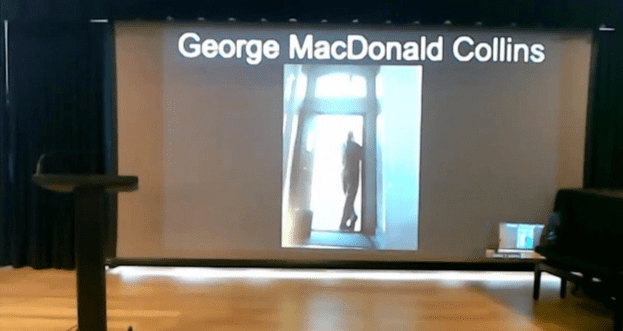
It’s a rainy Saturday afternoon in Newport Oregon and the “comfortable, modern lobby” of the Holiday Inn Express is uncharacteristically busy. The printer/copy machine has been in continual operation for a while as three 20 something young people, and what appears to be their father, uncle, grandmother and cousin, a ten-year-old girl, collaborate on an upcoming event. “We found these jazz albums in his record collection,” someone says, “so we need Ella Fitzgerald and Duke Ellington.” Someone else remembers, “How about Coltrane? What’s his first name? The attractive woman with the long blond braid seems to be in charge of the music, telling everyone, “Just get me the exact title of the song or piece you want, and I’ll find it on Spotify.” The tall slender young man appears to be editing a document, as the group decides to divide it into four segments so each grandchild can read a section. “Has anyone timed the reading of the whole thing?” someone asks.
This must be the way it looked to the hotel desk clerk, who asked me the following morning, “Were you preparing for a memorial?” Yes, I said, “You’ve heard of destination weddings – well, for our far-fling family, this is a destination funeral ritual. We’ve flown here from 5 different states to celebrate the life of our eldest member who lived here the last 20 years of his 94-year long life. He died five months ago. She didn’t ask, but the look on her face seemed to say, “Wow! Why would you go to so much trouble?”
To answer that question, even to myself I look to what grief expert Alan D Wolfelt calls, the six reconciliation needs of mourning.
Acknowledging the reality of the death.
When my father took me into the front parlor of his aunt’s home in rural Illinois to view her dead body lying in a casket there, the reality of her death was confirmed, if a bit scary to my young mind. In more recent times, church funerals and visitations help those who mourn to confront the reality of their loss. But Mary Frances O’Connor’s recent research and book The Grieving Brain confirms the fact that, even though we have been told of someone’s death, the brain holds on to the notion that the loved one is merely absent from our life presently, and likely to return. When the deceased person lives far away, and our contact with them is infrequent, the need for a ritual of confirmation of their death is enhanced.
Move toward the pain of the loss.
Healthy grieving requires communal support to feel and express our sorrow, – an occasion, and a ritual space. It was my grandchildren’s idea to fly a across the county and meet in person, invite the local people, to thank them personally for standing in for us, and supporting their grandfather in his last years. And to add to the degree of difficulty, to do a simultaneous online zoom of the event for friends and family across the country who couldn’t make the trip. Though this hybrid version of a celebration of a life was complex and difficult to pull off, it still would meet my mentor Anna Halprin’s definition, “Ritual is love made visible,” and a reminder that love is the core of what still survives and never dies.
Remember the person who died.
In the ritual space, and afterwards, the arts of storytelling, music, song, and photo images encourage recalling and remembering the deceased loved one and the part their life stories played in our individual ones. As to the biography the grandchildren put together and read, I’m not sure how many people contributed to it or who ended up doing the final edits, but it was a comprehensive document of events and influences through the years that connected us to our pain and provided solace for it.
Develop a new self-identity.
We each know a specific version of a person, depending on our relationship to them. George’s supervisor at the lighthouse where he’d written a book about its history and supervised its renovation, told some endearing stories that highlighted George’s determination to do the right thing, no matter what it took to accomplish that. After failing to influence the higher ups that the rocks someone dumped around the base of the lighthouse were causing water to seep in and threatened its survival, he wrote a letter to the editor of the local paper about the matter. When that didn’t change anything, he contacted his congressional representative, and, although the lighthouse was not a federal property, the rocks were removed, and the danger eliminated. “Everyone saw him as ‘the Keeper,’ he just made himself that. “He’s lucky he wasn’t an employee, or he’d have been fired,” the gentleman said with a laugh. Later, George’s son said, “You know I never saw much similarity between myself and my father, but when I heard that story I thought, “that’s me. I do that.”
Search for meaning.
As George’s former spouse, I decided to highlight for our grandchildren some of the events of his life that I’d been present for as examples of values and practices that I would like to see them continue in their own lives. They laughed when I mentioned there were plenty of things to avoid and not continue, but they probably already know what those were so no need to dwell on those.
The three things I would wish you to continue in your own lives are:
a. As a news broadcaster, George focused on what he knew to be important from the perspective of history and he was guided, not by uninformed opinion, but by what he knew to be true. This practice could guide us all through what’s been a rough patch in our public discourse of late.
b. We are all products of the times in which we live, and George’s time and experience happened during the quest for civil and voting rights for black people in our country. As a radio disk jockey while still in high school he featured and admired the innovators of jazz music, most of them African Americans. This, and his love of the improvisational art form of jazz gave him an “out of the box” way of thinking, and this quest for justice became personal to him. He was known for being, what we would call today, “an active ally” for this movement. My wish for our grandchildren is that you become involved in whatever issue is trying to happen to make the earth a better place for its inhabitants during your time here – so you will become part of the making of history as he was.
c. To George, love was an action word, which meant doing what you love and
sharing it with others. It meant stopping at the lighthouse to see if they had some plans he could copy to make a miniature wooden lighthouse for his grandsons. Then staying to become its keeper. May you find and do what you love and share it.
Receive ongoing support from others.
Something we learned during covid when it was taken away from us–we need funerals, memorials, and rituals to celebrate and appreciate what we have loved and lost. We need memories to sustain us as we build enduring connections to those that have gone before us, and perhaps to live out their legacy in our own lives. My 10-year-old granddaughter, Kyra, after telling a story of a fake telephone that her grandfather had given her, and how happy it made her when she was 6, and how happy it made him that she was happy with it she paused and said, “I guess the lesson we can take from his life is that even the small things can be really important.”

